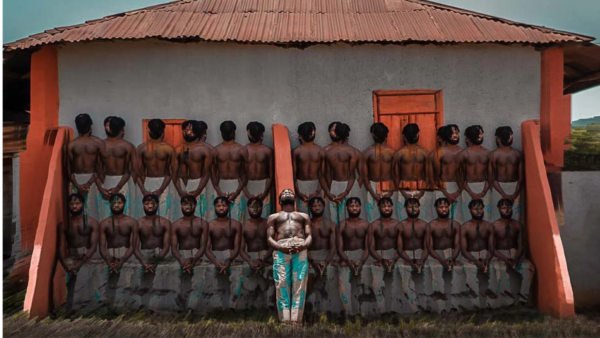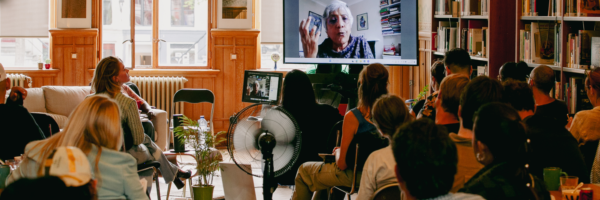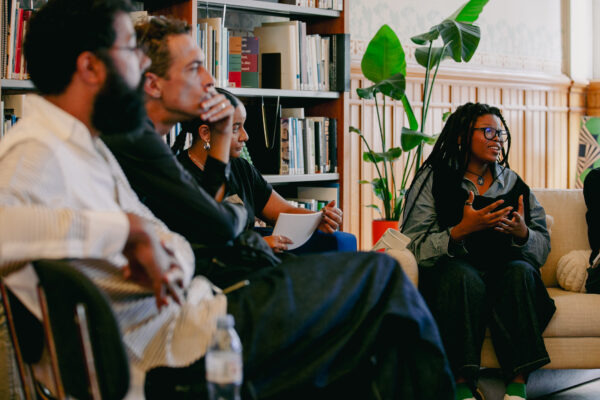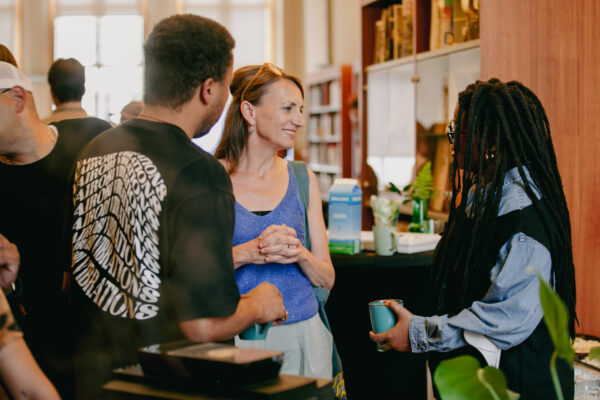

Design Dialogues on Climate (In)Justice
In the Global North, innovation and progress is the guiding narrative. But is this progress, in the form of industrial, technological or sustainable innovations, really progress when we look at the world as a whole? This is one of the key questions that came up frequently during the Design Dialogues on Climate (In)Justice symposium organised by the Creative Industries Fund NL.
Designers, makers and cultural professionals from eleven collaborative projects, supported through the Open Call Climate Justice, shared their approaches to a more climate-just world during the event on 28 August 2025. In addition, Vincent van Velsen and Miguel Peres dos Santos, Radha D'Souza and Daphina Misiedjan presented their work and methods to make climate injustice tangible and discussable. Writer Twan Eikelenboom attended the symposium and explores in this article how this group of makers – in collaboration with a large number of partners – develops alternative narratives to the dominant progress narrative.

Discovering and exploring stories
Through stories we give meaning to our world. This means they can also shape our understanding of a more climate-just world. Anyone who wants to contribute to such a world will therefore have to start by thoroughly investigating the stories of people and places. In these stories, the consequences of climate change itself resonate, but also those of an extractive progress narrative. Vincent van Velsen and Miguel Peres dos Santos created the exhibition Soengoe Kondre at the Nieuwe Instituut. Vincent: 'Central to the exhibition is the story of the Afobaka Dam. This dam caused large parts of land to be flooded. Where the Brokopondo reservoir is now, 6,000 people lived in Maroon communities. As a consequence families became separated. Some moved south because they did not want to live under the dam. Others went to the cities, or to villages built by the government.
Where the construction of the dam in the 1960s was presented as progress for Suriname, local communities saw little to no benefits. Miguel: 'By examining the context, we learned that the dam was mainly used to provide energy to an aluminium smelter. This development was part of a plan from the Netherlands, aimed at making Suriname economically independent. But the aluminium was intended for American aircraft, and the Maroon communities themselves received no energy from the dam – while the power lines ran over their houses.
The Maroon communities express resistance, but their stories receive little to no response. In the West we think from a perspective of progress. We want to teach others how we do things. But those roles should actually be reversed: we can learn so much from the Maroon communities. About the way they live in balance with nature, the spirituality, the connection with ancestors.'
The flip side of the colonial progress narrative
The stories of the Maroon communities show how much landscape, heritage and climate are connected. They make us realise that climate change and the consequences of extractive progress narratives are not only altering the landscape; the history and identity of communities are also being erased or rewritten. Tangible and intangible heritage is disappearing, and traditions associated with the land for generations are being lost. Progress is, Miguel says, ‘sold as a democratic form of innovation where everyone benefits, but the reality is often different.’

Jonas de Maeyer of Designing Tomorrow Together sees this happening as well in the context of climate policy and the energy transition: 'When we discuss climate change here, we ask questions such as: how can we electrify our European vehicle fleet? But its effects are having repercussions in the rest of the world. For example, minerals are needed for batteries and the obsolete cars end up in countries like Uganda, where we work with part of our team from Studio Akeka in the capital Kampala. The old cars create more air pollution and traffic, creating unsafe situations – including for children.'
If we look specifically at the impact of the large-scale energy transition that has begun in Europe, the consequences appear to be significant for the Moroccan region of Tangier and the area around the Ouarzazate solar power station. Lesia Topolnyk went to the area as part of New Ecological Order and shared her experiences: 'These are huge areas, bought from the indigenous people for a low price. The people were promised much, but the promises were never fulfilled. This leads to extractive practices, in which energy is funneled to European countries. In addition, the impact of mining in the region is also significant. I took a picture of residue from mining, but I spent a day in jail for doing that. They don't want you to see this because it goes against the carefully created image of a progressive country.'
Researching and sharing stories – with and from local communities – creates awareness of the need for climate justice. This awareness makes it clear that transformation does not begin by seeking solutions, but by recognising that affected communities themselves have the necessary knowledge and must be given the space to apply it. Amy Trejo from Tamos Juntos relates: 'We want to generate transformation, by amplifying the voices of those affected by the impacts of climate change. We bring the stories to the institutions, by training local artists in sustainability and involving residents in creative processes.'
Innovation is sold as a democratic form of progress where everyone benefits, but the reality is often different.
Reconsidering and reconceptualising definitions
By zooming in on examples and stories from local communities and challenging dominant narratives, it becomes clear that concepts are not neutral. Meanings are shaped by power relationships and world views. In addition, words can have other meanings in different parts of the world. When engaging in collaborations, awareness of narratives, words and (design) languages is therefore essential. It is essential to learn to think beyond concepts and narratives and get to know each other's stories, backgrounds and communities.
Amal Alhaag from Metro54 and initiative The Earth as a Wayfinder shares the following: 'Language is important. The words we use matter. This means that we need to be able to reconsider and reconceptualise the words we use. Where in one place in the world a word is needed and very common, in another place communities may not need that word at all. You therefore have to look carefully at your own role, from a position of humility. But you also need to look at how money flows, and how the ecosystem that you find yourself in is organised. For example, we ensure that most of the money we receive from the Fund reaches our partners.'
Regarding the reconceptualisation of words, Kantamanto Social Club is critically examining the concept of sustainability, in the context of fashion. How does its meaning differ in various parts of the world? Anabel Poh: 'Every year, 92 million tonnes of textile waste is produced, mainly by countries in the Global North. This ends up in countries around the world – including Ghana. We therefore asked the question: what if the future of fashion innovation does not lie in the institutions in the Global North, but is developed from the communities in the Global South?' What happens in this way is that the term sustainability is not defined from a position of extractive progress thinking. The narrative is placed in the hands of the people who bear the consequences.

Making alternatives a reality through imagination
By examining local stories and contexts and critically questioning leading definitions and narratives, we become aware that concepts and structures we have assumed to be true, sometimes for centuries, no longer work. By questioning the fundaments and imagining alternatives on that basis, we can, as writer and lawyer Radha D'Souza showed, change definitions and underlying structures.
Together with Jonas Staal, D'Souza is curator of the Court for Integenerational Climate Crimes (CICC): 'After years of working with activists, I realised that we are good at analysing, campaigning and building networks. But when it comes to solutions, we keep going back to the same law that created the problem. This is despite the fact that there is something fundamentally wrong with modern legislation: it is based on fictions. The legal person, in the form of a state or organisation, is one such fiction. Both are independent persons in the eyes of the law. But in reality, this is not the case.
In addition, we find that we do not have the necessary language to talk about nature and culture. As a result, we forget that humanity is one of many species on earth. We are part of nature. What characterises us as humans is that we need existing concepts, to understand and navigate the world around us. But if these concepts do not work, we need to modify them. For example, when we talk about climate, we are talking about airborne particles and emissions. However, this idea of climate is fundamentally incorrect. We therefore need to change the definitions.
Climate is about being able to reproduce the conditions necessary for life to exist. This means both the social and the ecological climate: everything that is necessary for life to sustain itself. This also means that climate is intergenerational, and everyone and everything is interdependent – humans as well as all other kinds of life. This is the basis for intergenerational life.'
We need concepts to understand the world. But if they don't work, then we must modify them.
To move people out of their comfort zone, the CICC mimics all the rituals of a real court case, ranging from the architecture to the way people dress and speak. D’Souza: 'The ritual remains recognisable, but the CICC erodes the content and puts new content in its place.' There is great power in imagining alternatives to existing systems and structures, as the CICC does, because it shows lawyers and legal scholars how another system might work.

For the creative and cultural sector, there is an important responsibility here. Artists, designers and researchers are actually uniquely capable of creating and reproducing new and alternative perspectives from the power of imagination. An example of a practice picking up this responsibility is Internet Teapot, initiator of the Climate Game Jam. Karla Zavala Barreda: 'Our studio specialises in critical and speculative design projects. This stems from our background in digital culture and creative theory. We believe that design in itself can be a socially transformative force. So we organised the Climate Justice Game Jam, with the aim of creating a space for makers where people from the Global South and North – and from all kinds of disciplines – could develop games together that are rooted in local designs and experiences.'
In addition, The Center for Genomic Gastronomy, together with, among others, Mock Wild Egypt, shows how imagination can lead to new perspectives and future visions for landscapes. Zack Denfeld: 'We are interested in ‘rewilding’ unusual landscapes. For instance Flevoland, but also Egypt and the Nile Delta. We then imagine futures for these areas, not only through speculative images, but also by creating dishes, for example.'
Ensuring reciprocity and transparency
What Internet Teapot and The Center for Genomic Gastronomy have in common is that in creating narratives and perspectives, they place the customs, stories and cultures of local communities at the centre. From this way of working, communal spaces can emerge, which bring together all kinds of disciplines and backgrounds – and in which place, nature and history also have a voice. The question is how to collaboratively organise these spaces in such a way that connections are no longer made from conceptions rooted in extraction, exploitation, positions of power and extractive narratives. In fact, communal space only works if it can be created from an attitude of reciprocity and humility – and an intrinsically shared desire to actually fundamentally strengthen local communities.
In ensuring reciprocity, transparency and awareness of power relationships at all stages of a project are essential. This starts, observes Lesego Bantsheng of Rural Futurisms, even before the project begins: 'Whoever sits at the table not only defines and shapes the collaboration, but also the hierarchy and power relationships within it. And who can be at the table is already determined in the conditions for funding. During collaboration, it is essential to provide full transparency towards partners and stakeholders in an area.'
But transparency is not an end in itself: 'Transparency helps to give others a voice in the choices you make, and let them see what their share of the pie is. And they can make suggestions on how best to deploy your resources. If they have more knowledge than you, they can do that. With Cybersyn 2, we actually place indigenous methods of knowledge development at the centre, such as the Kgotla: a traditional form of assembly where everyone gets to speak. We combine this with knowledge and experience in deploying digital platforms.'
Also for Unmaking the Model, transparency – and specifically understanding interrelationships – is an important part of the collaboration. Inspiration for this comes from the Ballroom scene. Roxette Capriles: 'We want to create a shared space for exchange, where we can come up with new ways of thinking and doing. Ballroom is a space, between worlds, that many people may not be familiar with. Black, queer and marginalised communities use Ballroom as a tool to survive and challenge dominant norms. Among other things, Ballroom shows that you need to understand interrelationships, in order to make major decisions together.'
Transparency helps to give others a voice in the choices you make, and let them see what their share of the pie is.
Developing from local context and knowledge
From a position of transparency and openness about relationships, power structures and relationships, a basis of mutual trust and reciprocity can emerge. If you then engage in a design and creation process from the common space you have created together, the knowledge and experience you bring in can only become of value if there is interaction with the local context. Sustainable use of materials, for example, is not a universal formula, but depends on the specific context – ranging from climate to available resources and local skills.
The methodology of architecture and research firm AP+E shows how to place local communities at the centre and achieve adaptive design approaches from a situation of equal collaboration. Jeffrey Bolhuis on Empowering the Informal City: ‘'In Cairo, we work with partners such as CLUSTER to strengthen informal structures and local communities in neighbourhoods. Among other things, we see that the city cannot withstand change in climate, and the escalating climate crisis. Neo-vernacular architecture is a way of developing, where you look to the past of a local community and place for solutions – but translate them forward into the present. Together with residents, this is how we develop climate-adaptive building solutions for houses, which can be scaled up to multiple neighbourhoods.'

This attitude, where place and local community take precedence in development, can create shifts in thinking about positions of power. We no longer see classical institutions as omniscient centres of power, but it is local communities and collaborations from which alternative designs and developments can emerge. However, positions of power are not limited to institutions. Disciplines also have limiting and intractable definitions that work against reciprocity. Tiago Vilas Boas of Design Reparations emphasised: 'Design supremacy is a big challenge. That is why we enter into relationships with communities and ecosystems based on reciprocity. This means looking beyond restrictive definitions of the design community and placing respect, wellbeing and the prevention of extraction at the centre of collaborations.'
What can be created in this way are shared spaces around local places and communities, where, on the one hand, choices and ways of working are not dictated from positions of power. And where, on the other hand, local knowledge and skills are not extractively claimed and appropriated by designers from the Global North. In reciprocal common spaces design and knowledge, local context and stakeholders – all life now and before – must be connected at all times.
Anticipate opposition by continuing to learn
Finally, when you challenge positions of power and ask people to step out of their comfort zone, it is good to realise that counter-reactions are inevitable. Daphina Misiedjan, whose research includes the impact of climate change on the Caribbean islands, aptly described this situation: 'When I talk about climate justice, I describe it as a storm. But in that storm, we are not all in the same boat. Some can certainly weather the storm. For example, they are on a cruise ship. Others, however, on small boats, are defenceless against the storm. And although they contribute the least to the storm, they bear the brunt of its consequences.' But those on the cruise ship, who are being challenged, will resist. 'A victory in court is a moment to celebrate, but we still do not take counter-reactions sufficiently into account. You have to prepare yourself for this, and not be surprised by it.'
Therefore, what is needed is to learn to recognise resistance without being paralysed by it. One way to do this is to identify clashing interests and respect different backgrounds in the common space you create with each other. But what is also important is that you are constantly learning. How does the context relating to a place change because of our actions? How do the definitions change? And who will be affected by these changes, in what ways?
The Creative Industries Fund NL regularly introduces new opportunities for international collaboration. The recently launched call Shifting Grounds is aimed at designers, makers and collectives who, in partnership with one or more organisations based on the African continent, wish to develop projects that address contested geologies. These are inhabited landscapes or ecosystems under pressure from conflicting economic, ecological and social interests. The deadline for submissions is 22 October 2025 at 16:00 CEST.






